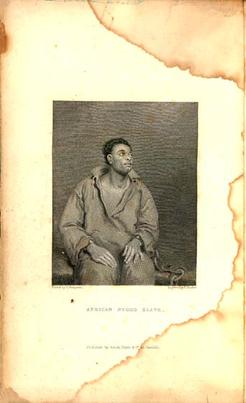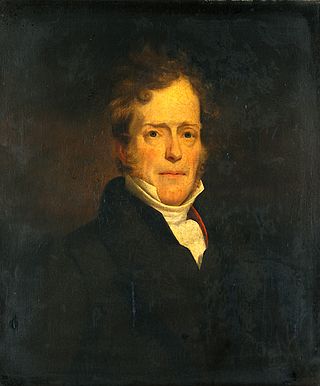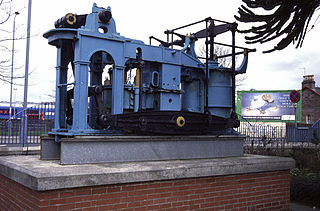Life
The youngest son of George Neilson, a calenderer, he was born in Glasgow on 24 September 1795. Educated at Glasgow High School and Glasgow University, he received business training at offices in the city, and then joined his father in exporting cambric and cotton goods to America. In 1820, on returning from a visit to the United States, he married his cousin, Elizabeth Robertson. [1]
From 1822 to 1828 Neilson was in America on business. His wife died about the time of his return to Scotland. In 1841 he settled in Kirkintilloch, Dumbartonshire, where an unmarried sister managed for him and his family of three daughters and one son. [1]
In his latter years Neilson suffered from heart disease, and he died at Kirkintilloch on 3 May 1861, and was interred in the burying-ground of Glasgow Cathedral. [1]
Works
On his return to Scotland, Neilson published Six Years' Residence in America, 1828. [1] It includes his visits to New York City in the 1822 outbreak of yellow fever, [2] [3] and to Harlem, [4] and details, now considered exaggerated, of the Lavinia Fisher murders in Charleston, where he claimed to have been in 1820. [5] He visited also Philadelphia, and New Orleans where he attended religious services. [6]
Neilson wrote poetry, and The Millennium and Scripture Gems were published in 1834. His collected Poems, edited with memoir by Dr. William Whitelaw, appeared in 1870. [1]
Neilson edited, or wrote, The Life and Adventures of Zamba, an African King; and his Experiences of Slavery in South Carolina (1846). Ostensibly this was a slave narrative by Zamba Zembola only edited by Neilson. He also contributed to the Glasgow Herald a series of articles on Cotton Supply for Britain. [1]

The 1820s was a decade of the Gregorian calendar that began on January 1, 1820, and ended on December 31, 1829.

Charles Macintosh FRS was a Scottish chemist and the inventor of the modern waterproof raincoat. The Mackintosh raincoat is named after him.

Admiral Sir Charles Elliot was a British Royal Navy officer, diplomat, and colonial administrator. He became the first Administrator of Hong Kong in 1841 while serving as both Plenipotentiary and Chief Superintendent of British Trade in China. He was a key founder in the establishment of Hong Kong as a British colony.
The Ballochney Railway was an early railway built near Airdrie, North Lanarkshire, Scotland. It was intended primarily to carry minerals from coal and ironstone pits, and stone quarries, in the area immediately north and east of Airdrie, to market, predominantly over the adjoining Monkland and Kirkintilloch Railway. Passengers were carried later.
The Monkland and Kirkintilloch Railway was an early mineral railway running from a colliery at Monklands to the Forth and Clyde Canal at Kirkintilloch, Scotland. It was the first railway to use a rail ferry, the first public railway in Scotland, and the first in Scotland to use locomotive power successfully, and it had a great influence on the successful development of the Lanarkshire iron industry. It opened in 1826.
Captain John Neilson Gladstone, was a British Conservative Party politician and an officer in the Royal Navy. A brother of politician William Ewart Gladstone, later British Prime Minister, he served as a Member of Parliament (MP) for most of the years 1841 to 1863.
William Laird was a Scottish shipbuilder and developer who was responsible for what later became the Cammell Laird shipyard, and for starting the substantial development of its adjoining town, Birkenhead, on the Wirral in England.
The following lists events that happened during 1820 in New Zealand.

Zamba Zembola is the supposed author of an 1847 slave narrative, The Life and Adventures of Zamba, an African Negro King; and his Experience of Slavery in South Carolina, which describes his kidnapping and 40 years of labor as a enslaved person on a plantation in the U.S. state of South Carolina. The work was edited by Peter Neilson, a Scottish abolitionist. Some scholars believe the book is not a genuine slave narrative but is fiction written by Neilson. Neilson refused to produce Zamba for inspection by anyone else.

Admiral Sir Fleetwood Broughton Reynolds Pellew CB KCH was an officer of the Royal Navy who served during the French Revolutionary and Napoleonic Wars.

The Seringapatam-class frigates, were a class of British Royal Navy 46-gun sailing frigates.

Admiral John Markham, was a Royal Navy officer. As a junior officer he served in the American Revolutionary War. He commanded the third-rate HMS Hannibal in the action of 10 April 1795 and then the third-rate HMS Centaur, capturing a French frigate squadron in the action of 18 June 1799, during the French Revolutionary Wars. He went on to be a Lord Commissioner of the Admiralty and First Naval Lord under Earl St Vincent. He also served as MP for Portsmouth.

During the American Civil War, blockade runners were used to get supplies through the Union blockade of the Confederate States of America that extended some 3,500 miles (5,600 km) along the Atlantic and Gulf of Mexico coastlines and the lower Mississippi River. The Confederacy had little industrial capability and could not produce the quantity of arms and other supplies needed to fight against the Union. To meet this need, British investors financed numerous blockade runners that were constructed in the British Isles and were used to import the guns, ordnance and other supplies, in exchange for cotton that the British textile industry needed greatly. To penetrate the blockade, these relatively lightweight shallow draft ships, mostly built in British shipyards and specially designed for speed, but not suited for transporting large quantities of cotton, had to cruise undetected, usually at night, through the Union blockade. The typical blockade runners were privately owned vessels often operating with a letter of marque issued by the Confederate government. If spotted, the blockade runners would attempt to outmaneuver or simply outrun any Union Navy warships on blockade patrol, often successfully.

In Scotland, the Industrial Revolution was the transition to new manufacturing processes and economic expansion between the mid-eighteenth century and the late nineteenth century. By the start of the eighteenth century, a political union between Scotland and England became politically and economically attractive, promising to open up the much larger markets of England, as well as those of the growing British Empire, resulting in the Treaty of Union of 1707. There was a conscious attempt among the gentry and nobility to improve agriculture in Scotland. New crops were introduced and enclosures began to displace the run rig system and free pasture. The economic benefits of union were very slow to appear, some progress was visible, such as the sales of linen and cattle to England, the cash flows from military service, and the tobacco trade that was dominated by Glasgow after 1740. Merchants who profited from the American trade began investing in leather, textiles, iron, coal, sugar, rope, sailcloth, glass-works, breweries, and soap-works, setting the foundations for the city's emergence as a leading industrial center after 1815.

John Robert Hume (c.1781–1857) was a Scottish surgeon and physician. He is cited as an example of a 19th-century medical career that arrived at a high position in the profession, without early qualifications.

Messrs Robert Napier and Sons was a famous firm of Clyde shipbuilders and marine engineers at Govan, Glasgow founded by Robert Napier in 1826. It was moved to Govan for more space in 1841. His sons James and John were taken into partnership in 1853.

John Thomson FRS FRSE PRCPE (1765–1846) was a Scottish surgeon and physician, reputed in his time "the most learned physician in Scotland". He was President of the Royal College of Physicians of Edinburgh from 1834 to 1836.
Several ships have borne the name Caledonia for Caledonia:
![]() This article incorporates text from a publication now in the public domain : Lee, Sidney, ed. (1894). "Neilson, Peter". Dictionary of National Biography . Vol. 40. London: Smith, Elder & Co.
This article incorporates text from a publication now in the public domain : Lee, Sidney, ed. (1894). "Neilson, Peter". Dictionary of National Biography . Vol. 40. London: Smith, Elder & Co.










